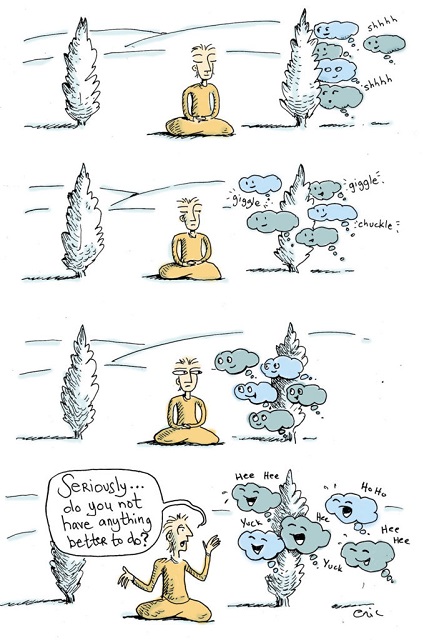
Have you experienced this?
Even when you sit down to meditate, thoughts do what they do. Do they have anything better to do?
Don’t ask the thoughts. They’re too busy worrying, planning, remembering, imaging—doing what they do—over and over.
Until you meditate, the relentless redundancy of thought is hidden. Before you begin to practice, you’re identified with thought. You don’t see the thoughts—you see through them.
Before meditation: When the worry-thought arises, you become worried. When the planning-thought arises, you get lost in planning. Whatever shape the thought takes, that becomes the shape of your experience.
Again and again: You keep sliding down the same well-grooved neural pathways again and again. You keep replaying the same unresolved emotional patterns again and again. But with practice, something shifts…
With meditation: As you practice, it becomes clear: the primary shape of thought is—busy. Meditation reveals the patterns of the untrained mind. If you’ve sat to meditate and been shocked by the running, ranting, raving of the mind—welcome to the club. You’re seeing what the average person never realizes: the untrained mind is incessantly busy. It’s a huge step forward on the path of awakening.
Here’s why…
All this activity isn’t an obstacle to meditation, it’s the gateway. Thinking is not an obstacle at all. Whatever is arising as thought, emotion or experience is the basis of your practice. Through skillful practice, you learn how to relate to thoughts and emotions in a way that reveals a deeper stillness.
A quiet mind can’t be forced. Using will power to quiet the mind is like pushing down on a spring. The harder you push—the more the spring pushes back. When you try to force the mind into stillness, it pushes back. When you argue with thoughts—they argue back. When you push on them, the thoughts heckle you. They laugh, becoming more agitated and disruptive.
So what helps the mind to settle down?
It’s done in the same way you get a glass of muddy water to become clear—you just let the mud settle. If you don’t stir up the water, the particles will settle without effort. Gravity does the work for you. It’s similar with meditation.
Meditation allows the busy thoughts and emotions settle. Instead of using gravity, meditation uses awareness. Awareness will do the work for you—if you don’t stir up the thoughts and emotions.
Letting awareness do the work takes a bit of—um…practice.
We’re all conditioned to stir up the mind, to churn up thoughts and emotions as the key to change. You’ve been trained that the way to solve problems and improve your life is by stirring the mud. But that’s not how it works when you’re on the path of peace, wisdom and an awakened life.
Peace of mind is revealed not created. Peace, wisdom, love—whatever it is you seek—is already present. These generative, healing qualities are here, immediately available. This is only obscured by your fixation on swirling thoughts and emotions.
Don’t just believe this—find out for yourself. Learn to meditate, and then practice daily. By daily, we don’t mean just for a day. We mean every day.
For how long? Hmm…how long does it take for mud to settle? It’s impossible to say. Rather than waiting anxiously—watching the clock—learn to practice skillfully and joyfully.
Cultivate meditative awareness and enjoy the process.
Sit. Breathe. Return again and again—until that which you seek is revealed to be ever-present. Enjoy how the mud settles. It’s beautiful.
Really, do you have anything better to do?
Love & Shanti,
E & D
.
**Author’s note: Most of the people who want to meditate—don’t. Most of the people who want to align with the power of sacred awareness—don’t. It’s not because they don’t want to. It’s not lack of willingness.
Here’s why: they don’t know how to practice skillfully, and they don’t get the on-going guidance and support they need. That’s why we’ve redesigned the Wisdom Heart Community to be simpler, easier and more powerful. The new design is based on your feedback. Thank you! We’ll re-open the door to the new Wisdom Heart Community later this month. Learn more here.
.
Author: Eric Klein
Editor: Yoli Ramazzina
Photo: original illustration by the author.










Read 38 comments and reply